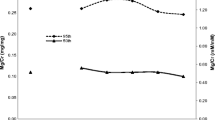Abstract
Zinc content of serum, hair and erythrocytes, urinary zinc excretion, zinc clearance (CZn) and the ratio of CZn to creatinine clearance (CCr) (CZn/CCr) were measured in 32 children aged between 2.1 and 14.4 years suffering from idiopathic nephrotic syndrome (INS) without renal failure (CCr>70 ml/min 1.73 m2 body surface area). Nineteen subjects had proteinuria and the remaining 13 were in remission. All children received calcium and vitamin D supplementation while on steroid therapy. There was high dietary zinc and protein intake. The results were compared with those obtained from 19 healthy subjects (aged 2–14 years). Zinc concentration in serum, erythrocytes and urine were measured by a colourimetric method. Proton induced X-ray emission was used to determine zinc content in hair. In patients both with and without proteinuria, the mean contents of serum, hair and erythrocytes were significantly lower than in the control group. The urinary zinc excretion, CZn and CZn/CCr in INS children were significantly higher than in the control group. A positive correlation was found between urinary zinc and protein excretion. In spite of high dietary zinc intake and normal intestinal absorption, children with INS had a zinc deficiency. This was probably caused by an increased urinary zinc loss.
Similar content being viewed by others
Abbreviations
- BSA:
-
Body surface area
- CCr :
-
creatinine clearance
- CZn :
-
zinc clearance
- INS:
-
idiopathic nephrotic syndrome
- RDA:
-
recommended daily allowance
References
Antoniou LD, Shalhoub RJ, Elliot S (1981) Zinc tolerance tests in chronic uremia. Clin Nephrol 16:181–187
Bensman A, Morgant G, Hasaerts D, Lasfargues G (1981) Diminution du taux serique du zinc dans le syndrome nephrotique de l'enfant. Nouv Presse Med 10:3779–3781
Carnovale E, Miuccio FG (1977) Tabelle di composizione degli alimenti. Ministero dell'Agricoltura e Foreste, Istituto Nazionale della Nutrizione. Roma
Di Toro R, Galdo Capotorti M, Gialanella G, Miraglia del Giudice M, Moro R, Perrone L (1987) Zinc and copper status of allergic children. Acta Paediatr Scand 76:612–617
Di Toro R, Gialanella G, Giordano V, Moro R, Perrone L (1989) Zinc metabolic status in children affected by chronic renal failure on conservative treatment. Trace Elem Med 6:60–63
Fairhall LT, Hoyt LH (1929) The excretion of zinc in health and disease. J Clin Invest 7:537–541
Fidanza F, Liquori G (1981) Nutrizione umana. Idelson, Napoli
Flynn A, Pories WJ, Strain WH, Hill OA jr, Fratianne RB (1971) Rapid serum-zinc depletion associated with corticosteroid therapy. Lancet II:1169–1172
Freeman RM, Richards CJ, Rames LK (1972) Zinc metabolism in nephrotic rats. Circulation 46 [Suppl 2]:72
International study of kidney disease in children (1978) The nephrotic syndrome in children. Prediction of histopathology from clinical and laboratory characteristics at the time of diagnosis. Kidney Int 13:159–165
Iolascon A, Perrone L (1985) Erythrocytic zinc content during childhood. Acta Haematol 4:1–3
Kleinknecht C, Gubler MC (1983) Néphrose. In: Royer P, Habib R, Mathieu H, Broyer M (eds) Néphrologie pédiatrique. Flammarion Medicine-Sciences, Paris pp 274–293
Linderman RD, Baxter DJ, Yunice AA, Kraikitpanitch S (1978) Serum concentrations and urinary excretions of zinc in cirrhosis, nephrotic syndrome and renal insufficiency. Am J Med Sci 275: 17–31
Makino T, Saito M, Horiguchi D, Kina K (1982) A highly sensitive colorimetric determination of serum zinc using water-soluble pyridylazo dye. Clin Chim Acta 120:127–135
Maskova H, Schuck D, Lepsi P (1986) Renal excretion of Zn in patients with chronic renal insufficiency. Trace Elem Med 3:76–80
McCance RA, Widdowson EM (1942) The absorption and excretion of zinc. Biochem J 36:692–696
Moro R, Gialanella G, Di Toro R, Perrone L, Giordano V (1988) Zinc determination in erythrocytes by a colorimetric method. Trace Elem Med 5:123–125
Prasad AS (1985) Diagnostic approaches to trace element deficiencies. In: Chandra RK (ed) Trace elements in nutrition of children, Raven Press, New York, pp 17–39
Reimold EW (1980) Changes in zinc metabolism during the course of the nephrotic syndrome. Am J Dis Child 134:46–50
Sandstrom B, Arvidsson B, Cederblad A, Bjorn-Rassmussen E (1980) Zinc absorption from composite meals. I. The significance of wheat extraction rate, zinc, calcium and protein content in meals based on bread. Am J Clin Nutr 33:739–745
Temes-Montes XL, Picaporte MA, Herrero E, Selgas R, Beberide JM, Martinez-Ara J, Sanchez-Sicilia L (1980) Valores séricos ψ urinarios de cinc en nefropatias exteriorizadas por sindrome nefrotico o como proteinuria en rango nefrotico. Riv Clin Espanola 159:159–161
Author information
Authors and Affiliations
Rights and permissions
About this article
Cite this article
Perrone, L., Gialanella, G., Giordano, V. et al. Impaired zine metabolic status in children affected by idiopathic nephrotic syndrome. Eur J Pediatr 149, 438–440 (1990). https://doi.org/10.1007/BF02009668
Received:
Accepted:
Issue Date:
DOI: https://doi.org/10.1007/BF02009668




